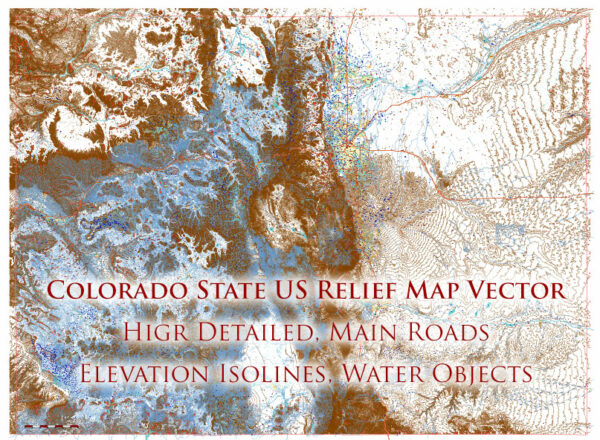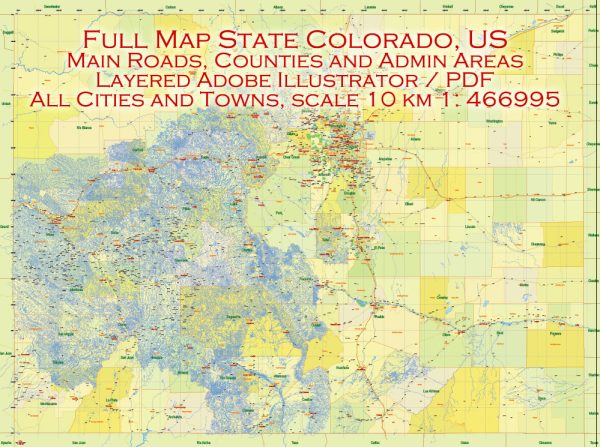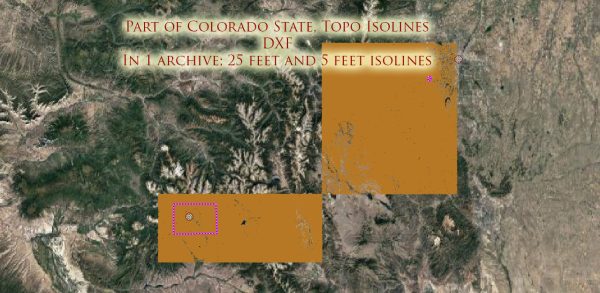The history of railroads and road systems in Colorado is rich and closely tied to the state’s development and growth.
Vectormap.Net provide you with the most accurate and up-to-date vector maps in Adobe Illustrator, PDF and other formats, designed for editing and printing. Please read the vector map descriptions carefully.
Here’s a detailed overview of the evolution of railroads and road systems in Colorado:
Railroads:
- Early Years (1860s-1870s): The first railroads in Colorado were constructed during the 1860s and 1870s to support the booming mining industry. These early rail lines primarily connected mining towns and resource-rich areas to major transportation hubs.
- Denver & Rio Grande Railroad (1870s-1880s): The Denver & Rio Grande Railroad played a crucial role in Colorado’s transportation history. It expanded rapidly, connecting Denver with mining regions and eventually reaching as far south as Durango. The railroad was instrumental in transporting ore, coal, and passengers across the state.
- Atchison, Topeka and Santa Fe Railway (1880s-1890s): The Santa Fe Railway extended its lines into Colorado, providing additional connectivity and facilitating the transport of agricultural products and goods. This expansion contributed significantly to the state’s economic development.
- Colorado Midland Railway (1880s-1910s): This railroad was built to serve the mining districts of Leadville and Aspen. It also played a role in tourism, carrying passengers to the scenic areas of the Rocky Mountains.
- Decline and Consolidation (1920s-1940s): The decline of mining activities and the rise of automobile and truck transportation led to a decrease in the importance of railroads. Many rail lines were abandoned or consolidated during this period.
- Modern Era (1950s-Present): The mid-20th century saw further decline in rail transportation as highways and air travel became dominant. However, some rail lines persisted, particularly for freight transport. In recent years, there has been renewed interest in commuter rail projects like the RTD A Line connecting Denver International Airport to downtown Denver.
Road Systems:
- Territorial Roads (1850s-1860s): Before Colorado became a state, early trails and roads were established to facilitate trade, travel, and military movements. Some of these routes later became the basis for modern highways.
- Automobile Era (early 1900s): With the rise of automobiles, the demand for improved road systems increased. The construction of highways and paved roads became a priority, connecting urban centers and facilitating tourism and commerce.
- Federal Aid Highway Act (1956): The Federal Aid Highway Act of 1956, also known as the National Interstate and Defense Highways Act, had a significant impact on Colorado’s road infrastructure. It led to the construction of the Interstate Highway System, including Interstates 25, 70, and 76, which traverse the state.
- Expansion and Upgrades (1960s-1990s): Colorado continued to expand and upgrade its road network to accommodate the growing population and increased traffic. This included improvements to existing highways and the construction of new roads.
- Public Transportation (2000s-Present): In recent years, there has been a growing focus on public transportation options, including bus rapid transit and light rail services in the Denver metropolitan area. Efforts are ongoing to address traffic congestion and promote sustainable transportation solutions.
The history of railroads and road systems in Colorado reflects the state’s economic shifts, from the initial reliance on mining to the modern emphasis on diverse industries and tourism. The development of transportation infrastructure has played a crucial role in shaping Colorado’s growth and connectivity.





 Author: Kirill Shrayber, Ph.D.
Author: Kirill Shrayber, Ph.D.